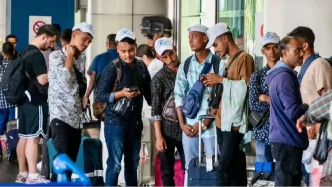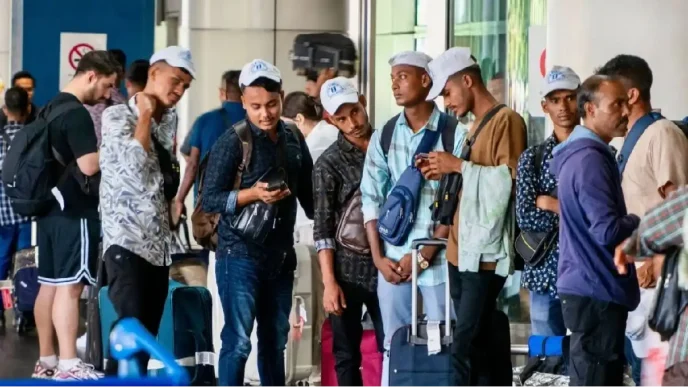Thailand and Nepal have embarked on a renewed chapter of diplomatic and economic collaboration, marking the first official visit by a Nepalese prime minister to Bangkok in 66 years. On April 2, 2025, Prime Minister Paetongtarn Shinawatra welcomed Rt. Hon. Mr. K P Sharma Oli and his spouse at Government House, a symbolic gesture underscoring the deepening ties between the two nations. The visit, coinciding with the 66th anniversary of diplomatic relations, saw the signing of eight agreements and Memoranda of Understanding (MoUs), setting the stage for enhanced cooperation in trade, tourism, and regional development.
A Milestone in Bilateral Relations
The historic meeting between the Thai and Nepalese leaders highlighted a shared commitment to strengthening ties across multiple sectors. Prime Minister Shinawatra praised Nepal’s strides toward developing country status, noting its significant potential in hydropower and other industries. In response, Prime Minister Oli expressed Nepal’s eagerness to bolster cooperation at both bilateral and regional levels, emphasizing the importance of high-level exchanges and existing mechanisms like the Joint Commission Meeting.
The cultural and spiritual connections between the two nations were a focal point of the discussions. Thousands of Thai Buddhists make an annual pilgrimage to Lumbini, the birthplace of Buddha in Nepal, a tradition that both leaders recognized as a cornerstone of their relationship. This shared heritage provided a backdrop for agreements aimed at promoting Buddhist tourism, with Nepal also expressing interest in learning from Thailand’s expertise in medical tourism, a sector where the Southeast Asian nation has established itself as a global leader.
Trade and Investment Take Center Stage
One of the most significant outcomes of the visit was the commitment to expand trade and investment. Both countries identified agriculture, herbal processing, medical services, and tourism as key areas for collaboration. Thailand signaled its intent to increase its business presence in Nepal, while the Nepalese government pledged to reduce trade barriers to attract Thai investors. The potential for growth in these sectors is substantial, given Nepal’s emerging market status and Thailand’s established economic infrastructure in the region.
Agriculture emerged as a particularly promising field, with Thailand offering to share its expertise in processing and technology transfer. Herbal products, a niche but growing industry in both nations, were highlighted as an area for joint innovation. The agreements signed during the visit are expected to facilitate knowledge exchange and capacity building, providing a framework for long-term economic partnerships.
While specific financial figures for investment deals were not disclosed, the emphasis on reducing trade barriers suggests a proactive approach to fostering economic ties. Analysts note that Nepal’s strategic location and natural resources, particularly in hydropower, could complement Thailand’s industrial and technological capabilities, creating a mutually beneficial dynamic. If implemented effectively, these initiatives could position both nations as stronger players in the regional economy, particularly within frameworks like the Bay of Bengal Initiative for Multi-Sectoral Technical and Economic Cooperation (BIMSTEC).
Tourism and Cultural Exchange as Catalysts
Tourism, especially Buddhist tourism, was identified as a sector with immense potential. The annual flow of Thai pilgrims to Lumbini not only strengthens cultural ties but also contributes to Nepal’s economy. Both leaders agreed to enhance cooperation in this area, with plans to develop joint tourism packages and improve infrastructure to accommodate growing numbers of visitors. Nepal’s interest in Thailand’s medical tourism model also opens avenues for collaboration, potentially positioning Nepal as a complementary destination for wellness and spiritual travel.
Beyond tourism, the visit underscored the importance of people-to-people connections. Thailand offered scholarships and training programs in hospitality, agriculture, and public health, while Nepal expressed a desire for knowledge exchange to support human resource development. These initiatives reflect a broader vision of fostering goodwill and understanding between the two societies, laying the groundwork for sustained collaboration.
Regional and Multilateral Cooperation
The discussions extended beyond bilateral concerns to address regional and global challenges. Both nations committed to working together within BIMSTEC and other multilateral forums, with a particular focus on climate change. Nepal, vulnerable to the impacts of global warming due to its Himalayan geography, stands to benefit from Thailand’s experience in environmental policy and disaster management. Prime Minister Oli’s condolences for a recent earthquake in Thailand further highlighted the shared challenges faced by the two countries, reinforcing the need for collaborative solutions.
Thailand’s role as a regional hub in Southeast Asia and Nepal’s position as a gateway to the Himalayas offer strategic opportunities for cooperation. Analysts suggest that joint efforts within BIMSTEC could amplify their influence on issues like sustainable development and regional connectivity. However, the success of these commitments will depend on consistent follow-through and the ability to navigate geopolitical complexities in the broader South and Southeast Asian regions.
Personal Diplomacy and Future Engagements
The personal rapport between Prime Ministers Shinawatra and Oli was evident throughout the visit. Oli extended an invitation to Shinawatra to visit Nepal, a gesture that signals the intent to maintain momentum in high-level exchanges. Such visits are crucial for building trust and ensuring that the agreements signed translate into tangible outcomes. The warmth displayed during the meeting at Government House, coupled with the symbolic timing of the 66th anniversary, suggests a genuine desire to elevate the partnership to new heights.
Prime Minister Oli’s public statements following the visit reinforced this sentiment. “This visit has strengthened Nepal-Thailand relations” he declared, as reported by local outlets, reflecting optimism about the future of the partnership. While specific details of the eight MoUs remain under wraps, their signing marks a formal commitment to collaboration, providing a roadmap for future negotiations and projects.
Challenges and Opportunities Ahead
Despite the optimism, challenges remain in translating diplomatic goodwill into concrete results. Nepal’s bureaucratic hurdles and infrastructure constraints could slow the pace of investment and trade initiatives. Similarly, Thailand must balance its commitments to Nepal with its broader regional obligations, ensuring that resources and political capital are allocated effectively. If unaddressed, these issues could temper the ambitious goals set during the visit.
Moreover, the economic disparity between the two nations poses both a challenge and an opportunity. Thailand’s more developed economy could drive investment in Nepal, but there is a risk of creating dependencies rather than equitable partnerships. Both governments will need to prioritize mechanisms that ensure mutual benefit, such as joint ventures and capacity-building programs, to avoid imbalances in the relationship.
Public sentiment in both countries appears broadly supportive of the renewed ties. Social media posts and local reports indicate enthusiasm among Thai and Nepalese citizens for closer cultural and economic links, particularly in tourism. However, sustained public engagement will be necessary to maintain this momentum, especially as the outcomes of the agreements become clearer in the coming months and years.
A Forward-Looking Partnership
As Thailand and Nepal chart a path toward deeper collaboration, the visit by Prime Minister Oli serves as a reminder of the potential for small and medium-sized nations to forge meaningful partnerships. The focus on trade, tourism, and regional cooperation reflects a pragmatic approach to diplomacy, one that prioritizes shared interests over geopolitical rivalries. Yet, the true test lies in implementation—whether the eight MoUs signed on April 2 will yield measurable progress or remain symbolic gestures.
For now, the streets of Bangkok and Kathmandu buzz with cautious optimism. As pilgrims continue to traverse the spiritual path to Lumbini and businesses explore new frontiers, the question remains: can this historic visit lay the foundation for a partnership that endures for another 66 years? Only time will tell, but the seeds of collaboration have undoubtedly been sown.














